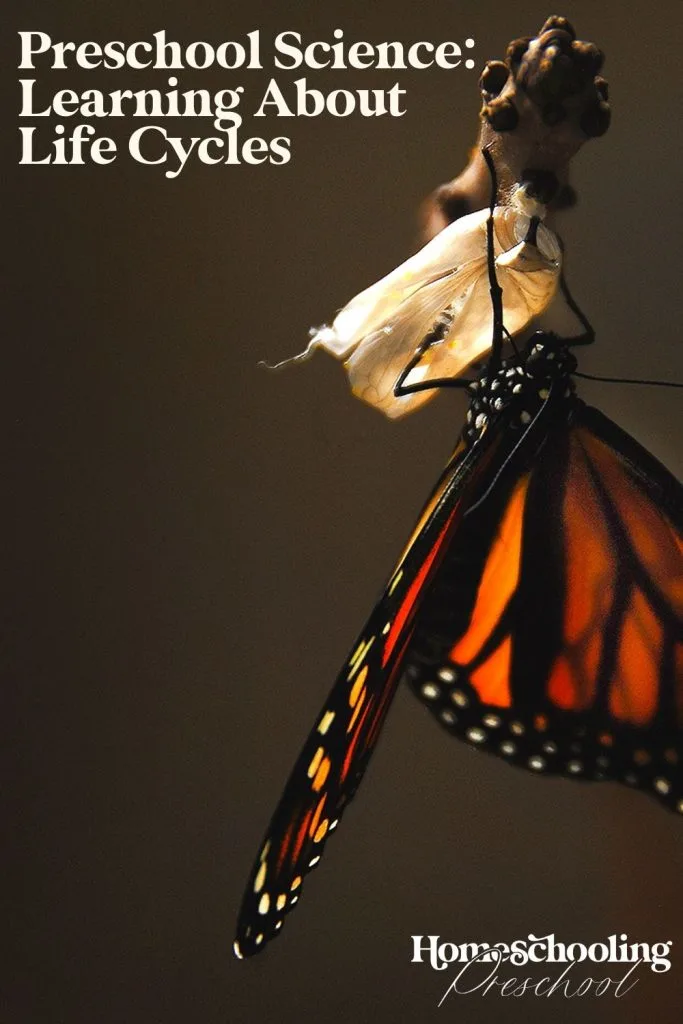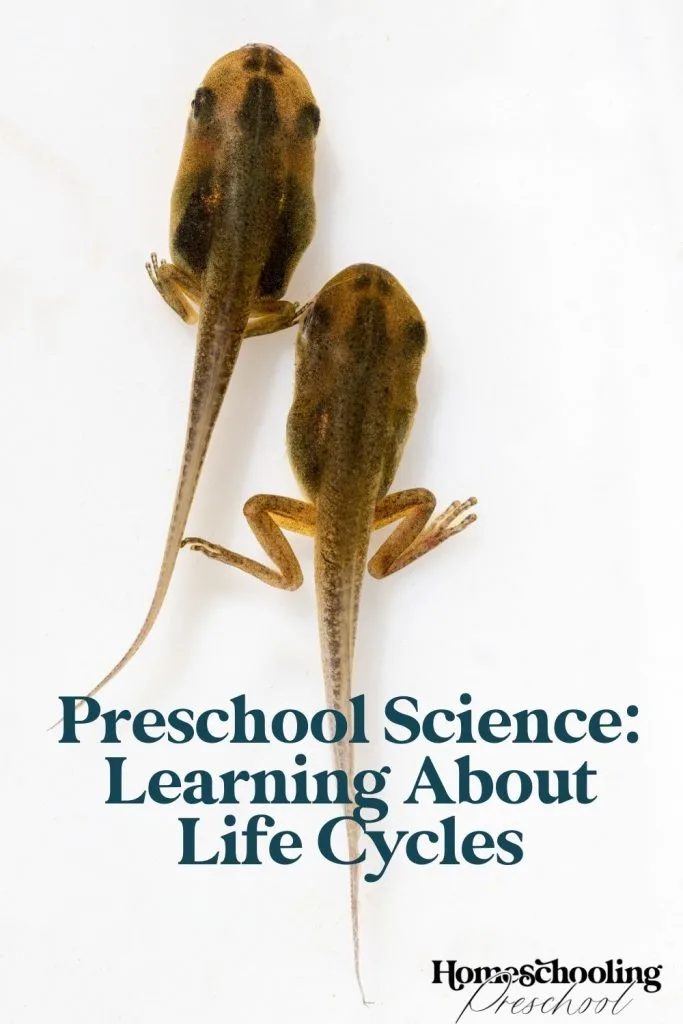Are you looking for engaging preschool science topics?
Try learning about life cycles!
Learning About Life Cycles of Animals and Plants
The natural world is a fascinating place.
It contains a variety of plants and animals of every size and color.
Children are entranced by nature, so why not make nature a focus of your preschool science study?
Learning about life cycles is a great place to start.
Think about it: Animal life cycles are so different!
This is especially true for insects and amphibians.
Plant life cycles are equally amazing: a mighty oak grows from a single acorn; a fern has two adult forms; an apple grows from a seed shaped like a black teardrop.
Life cycles will captivate your little learner.

This article may contain affiliate links to products that may help you when homeschooling preschool.
This article may contain affiliate links to products that may help you when homeschooling preschool.
The Benefits to Learning About Life Cycles
With all the incredible areas of science, why should you consider focusing on life cycles in preschool?
Here are some benefits:
Plants and animals are all around us
Young children learn by exploring.
Your young learner may not blast into space or dive deep into the ocean, but he will see plants and animals every day.
Plants and animals are everywhere–from the country to the city.
Animals are interesting
Who can resist the cuteness of a fuzzy yellow chick or the beauty of a blue Morpho butterfly?
Living things hold a fascination for all of us–your preschooler included.
Life cycles practice sequencing
When you study life cycles, you learn events in a sequence.
Recalling a life cycle in order is a great way for your little learner to practice sequencing, a critical thinking skill.

5 Fascinating Life Cycles to Study
With so many plant and animal species out there, which ones do you choose?
Here are some animal life cycles and plant life cycles to consider.
Ladybug Life Cycle
Insect life cycles are incredible because they go through distinct phases.
Ladybugs are no different.
Did you know they have a pupa stage like a butterfly?
If you saw a ladybug larva, you probably wouldn’t recognize it!
Butterfly Life Cycle
Perhaps the most famous of the animal life cycles, the butterfly is an ideal animal to study.
What other animal begins so humbly and turns into such a beautiful creature?
And beauty isn’t its only wonder.
A monarch migrates 3,000 miles!
Chicken Life Cycle
What came first the chicken or the egg?
You may not answer this riddle, but you will have fun learning about how a chicken lays an egg and–days later–a chick emerges.
Frog Life Cycle
A tadpole looks remarkably like a fish–that is until it sprouts legs!
Frogs undergo an amazing life cycle change from water breathers to air breathers.
Plant Life Cycles
Seeds are incredible because they contain the baby plant and all that it needs to grow.
Preschoolers will be fascinated by the life cycles of plants that they know (and eat) like pumpkins, apples, and even sunflowers.

How to Teach Animal Life Cycles
Preschool science should be as hands-on as possible.
Use games, crafts, printables, and experiments when learning about life cycles.
Check Out Science Books
Books still have their place in preschool science.
I love to use books with glossy color photos: the bigger, the better.
Books are a great way to introduce the life cycle of the week.
Use Printables
Crafts and printables are great ways to learn about life cycles and practice sequencing.
Kids can color, cut, and paste their way through learning about life cycles.
See It In Real Life
Get outdoors and step into nature!
Look for frogs in the pond or ladybugs and butterflies on flowers.
You can also visit a garden center or local farm to touch and feel plants (or pick your own).
Visit a petting zoo or local farm to see baby animals and their parents.
Grow Your Own
Your child can be an eyewitness to the cycles of life.
Grow beans or sunflowers from seeds.
Purchase a “butterfly garden” kit and watch the caterpillars turn into butterflies before your eyes.
Put a birdhouse in your yard.
Find some frogspawn in a nearby pond or purchase a frog growing kit (they will send you tadpoles in the mail).

Preschool Science: Learning About Life Cycles
Life cycles are an excellent choice for homeschool preschool science.
You will love learning and discovering with your child the way plants and animals change and grow.
